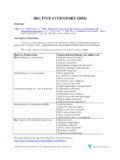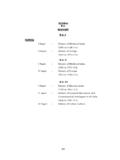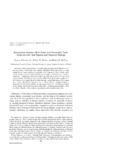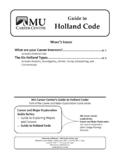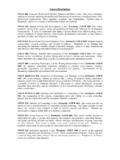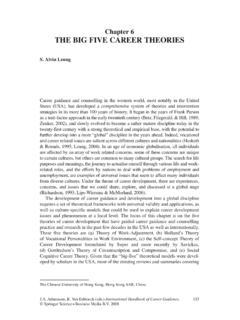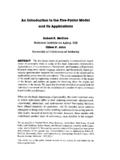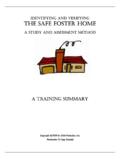Transcription of The History of Personality Theory and Assessment
1 The History of Personality Theory and AssessmentThe History of Personality Theory and Assessment | 2 Summary ..3 Hippocrates through the Middle Ages ..3 Eighteenth Century Medicine ..3 Nineteenth Century ..3 Twentieth Century ..3 Missing the Mark ..5 History of the Color Code ..5 Motive: The Key to Self-awareness ..5 Driving Core Motive ..5 Needs and Wants ..6 Instincts/Preferences ..6 Personality Filters ..6 Values and Behavior ..7 Character ..8 Back to Your Roots ..8 Importance of Knowing an Individual s Driving Core Motive ..8 Core Motive and Natural Talents ..9 Summary ..9 Table of ContentsThe History of Personality Theory and Assessment | 3 SummarySince ancient times, humans have sought to explain behavior by categorizing personalities into distinct types. Personality assessments have been developed over the past several centuries to describe aspects of a person that remain stable throughout a lifetime: the individual s character pattern of behavior, thoughts, and feelings.
2 Personality assessments have been used to sort, classify, and categorize people. References to Personality assessments have even made their way into books and movies such as Harry Potter, who was placed into the Gryffindor House at the Hogwarts School by a sorting hat that could gauge the temperament of each student. Hippocrates through the Middle AgesHippocrates recorded the first known Personality model, postulating that one s persona is based upon four separate temperaments. Another Greek physician, Galen, extended Hippocrates Theory by applying a body fluid to each temperament: blood, mucus, black bile and yellow bile, respectively. Different diseases and behaviors had roots in the four humors and the fluid that was dominant was said to be the person s humor. The four humors Theory was to become a prevalent medical Theory for over a millennium after Galen s death. The Theory experienced widespread popularity throughout the Middle Century MedicineBy the 18th century, medicine was advancing rapidly.
3 The discoveries of the functions of the circulatory, respiratory and digestive systems served to discount the four humors Theory as a realistic practice of medicine. However, it remained important in terms of designating Personality . Nineteenth CenturyLate 19th/early 20th century physiologist Wilhelm Wundt expounded on the four humors Theory in 1879 and he is noted to be the first person to make clear distinction between human body and Personality . Wundt realized that temperaments could not be limited to the body fluids. He theorized that four temperaments sanguine, phlegm, cholera and melancholy were actually four dimensions of the human Personality and no individual was completely of one temperament; rather that everyone typically has varying proportions of two or more. He believed that all four temperaments were basic dimensions of the human Personality and that the temperaments fell along axes of changeability and emotionality .Twentieth CenturyThe rapid growth of the field of psychology beginning in the early 20th century led to increased interest regarding individual Personality .
4 The following represent philosophers originating theories at the turn of the century:Sigmund Freud posited a structural model of the mind in which id, ego, and superego (the three components of the human mind) interacted and wrestled with each other for dominance. The result of this constant struggle is the whole of each human s Humors:BloodMucusBlack BileYellow BileFour Temperaments:SanguinePhlegmCholeraMelanc holyThe History of Personality Theory and Assessment | 4 Eduard Spranger, a German philosopher, theorized four attitudes towards ethical values. He named those attitudes as artistic, religious, theoretic and economic. Henry C. Link wrote a book Employment Psychology. He writes that ideal Personality testing method can be a big machine that received data on one end and sorts the suitable candidates for the specific jobs on the other. The German philosopher presented a Theory of four character styles. He thought that people can be hypomanic, depressive, hyperesthetic or anesthetic depending upon their character styles.
5 Erich Fromm, another German philosopher wrote that there are four human orientation; exploitative, hoarding, receptive and Jung, a younger colleague of Freud s, categorized mental functioning again into four principle categories: sensing, intuition, thinking, and feeling. Jung believed that although we could develop all functions, his experience working with clients was that sustainable mental health was the result of using and leading with our natural lead function. According to Jung s suggestion that there are four fundamental ways we deal with the world: sensing, intuition, thinking, and feeling, we each have a preferred way usually the way we are most comfortable with and best at was developed by Katharine Briggs and her daughter Isabel Briggs Myers. They thought that knowing Personality preferences would help women entering the workforce for the first time during WWII choose jobs they were most comfortable and effective doing. The MBTI test takes Jung s Theory and asks questions that do not put people in categories of good or bad.
6 Instead, the outcome from the test encourages people to become more self-aware. Abraham Maslow believed humans are driven to achieve their maximum potential and will always do so unless obstacles are placed in our way. Maslow developed a pyramid called the Hierarchy of Needs, that explains his Theory best. Humans have specific needs that must be met. If lower level needs go unmet, we cannot move up to meet the next level needs. At the lower level we must focus on basic needs such as food, sleep, and safety. If we don t get food or if we go without sleep, it is impossible to focus on the higher level needs such as self-esteem or to reach the level of B. Watson in responding to theories popular in the early 20th century, asserted that all things done by organisms, including those by humans like acting, thinking and feeling should be regarded as behaviors. Theorist believe that all behaviors are observational whether the actions are publicly displayed or of a private nature, such as thinking and belief in nurture over nature is a second fundamental characteristic of behaviorists.
7 They believe that the mind begins as a blank box, so the environment has a singular influence over one s behavior. According to Watson, morality,creativity,spontaneity,problem solving,lack of prejudice,acceptance of factsSelf Actualizationself-esteem, confidence,achievement, respect of others, respected by othersEsteemfriendship, family, sexual intimacysecurity of body, of employment, of resourcesof morality, of the family, of health, of propertyLove/Belongingbreathing, food, water, sex, sleep, homostasis, excretionSafetyPhysiologicalMaslow s Hierarchy of NeedsThe History of Personality Theory and Assessment | 5 the environment in which a child is raised determines intelligence, temperament, and other Personality characteristics of that child; genetics are unimportant. The following is a famous quote by Watson: Give me a dozen healthy infants, well-formed, and my own specified world to bring them up in and I ll guarantee to take any one at random and train him to become any type of specialist I might select doctor, lawyer, artist, merchant-chief, and, yes, even beggar-man and thief, regardless of his talents, penchants, tendencies, abilities, vocations, and race of his ancestors.
8 Missing the Mark The various models previously described are all behavior-based and thus, they skip the critical step: motive. They go as deep as the needs and wants of an individual influencing behavior, but they fail to grasp what creates those needs and wants. Dr. Taylor Hartman maintains behavior is only an outward expression of what is truly happening on the inside of a person. Behavior-based models simply identify what people do, but we need to go much deeper; we need to know why they do it. History of the Color CodeThe Theory of a driving core motive (DCM) to answer the questions of why was originated by Dr. Hartman. With a in Human Behavior and Leadership, he documented his ideas on motive in a book, The Color Code. Motive: The Key to Self-awarenessWhile self-awareness is the key to building emotional intelligence, motive is the key to building self-awareness. The Color Code is based on this premise.
9 Understandably, many people don t comprehend the difference between behavior and motive. After all, behavior has been the focus of academia for nearly 50 years. The problem with behavior, however, is that it limits us to observing merely what people do. Motive, on the other hand, enables us to understand why people do what they do, and allows us to create lasting, effective change. Behavior is infinitely limited, because it is easily masked or imitated and, like the tip of an iceberg, it shows only a portion of the big picture. Motive, however, is an understanding of why people behave the way they do, which gives a big-picture view of the truth behind the behavior. Driving Core MotiveLet s start with driving core motive (DCM). This is the critical piece of who you are that sets The Color Code apart from other psychological Assessment theories and The History of Personality Theory and Assessment | 6 tools. As you can see from the illustration, DCM provides the immutable foundation for who you are.
10 DCM is not learned or developed. It is innate and will always fundamentally drive our individual choices. Irrespective of our behavior in various situations or at different times in our lives, our DCMs came with us at birth and will never change. DCM induces a person to act in a certain way and provides an inborn set of preferences. DCM is the root of what we think and do. It is the driving force behind our personalities. DCM is to our personalities what breathing is to the human body. You don t have to think about it, it is subconscious, Color Code, indentifies DCM by using four colors: Reds, power; Blues, intimacy; Whites, peace; and Yellows, fun. Each DCM drives a pattern of predictable strengths and limitations. Typically, an individual will have the most strengths and limitations common to his/her DCM with some combination of strengths and/or limitations from other DCMs. The most important thing you can do is to understand the significance of driving core motive.
